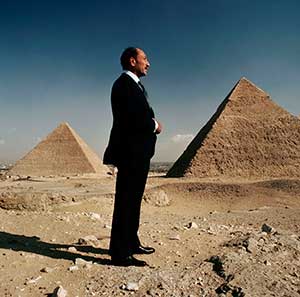

Thanks to rising sea levels and elevated temperatures, soon most of us will be living on the littoral or in the trackless wasteland. Such a dire prospect adds a bit of future frisson to the past visions of “Shifting Sands: The Beach and the Desert in 20th-Century Photographs.” This small but carefully sifted exhibition at Stanford’s Cantor Arts Center reveals both the beauty and the anxiety evoked by crowded shores and desolate dunes.
Weegee’s 1955 photo of a woman sprawled on a beach blanket with her face emerging from the sand a foot or so to the left of her torso relies on a simple double-exposure trick for a bit of surrealist whimsy.
In Max Yavno’s Muscle Beach (1949), the Santa Monica hot spot roils with action. A centered, foregrounded man and woman stare at a bustling sea of sunbathers, body builders, gawkers and hawkers—so many people that the beach is nearly obscured.
San Luis Obispo County’s Oceano dunes, by contrast, are devoid of people in Edward Weston’s pair of nearly abstract shots from 1936 in which rivulets of sand are rendered as pure patterns. The only signs of life intruding on this timeless vista are faint animal tracks. What might be a sinuous snake trail cuts diagonally against the overall vertical movement of the sand.
Known for his Yosemite landscapes, Ansel Adams worked just as effectively at close range. His Dunes, White Sands, New Mexico (1941) frames a shrubby dune as if it were a majestic Sierra peak. Low-in-the-sky sunlight rakes across the hillock from the left, creating sharply angled shadows of the vertical spikes of the vegetation, which the camera records with microscopic precision.
The vastness of the desert world appears nicely twinned in Edward Curtis’ Canyon de Chelly (1904) and Mexican photographer Manuel Alvarez Bravo’s Bicicletas en Domingo (not dated). In the former, tiny silhouetted horsemen (and one dog) traverse the open space in front of a looming escarpment—an image so iconic of the frontier that it appears in many Hollywood Westerns. In Bravo’s photo, four Sunday cyclists pedal off across a great plain bordered only by a remote line of mountains. They appear intrepid but ill prepared for such a journey.
All of the above are classic black-and-white gelatin silver prints (except for the Curtis, an Orotone print drenched in a golden brown hue). The few color selections evince a growing sense of unease about wide-open spaces.
Richard Misrach’s large chromogenic print Big Bomb, Little Bomb, Bravo 30 Bombing Range (1986) stares anxiously at two pieces of leftover ordnance resting on the sand in front of a scruffy clump of yellow brush. They could remain inert for decades or go off in our faces any minute now.
Also by Misrach, Road Blockade and Pyramids, Egypt (1989) relies on a disorienting juxtaposition of dimensions. A long, empty road is nominally barricaded by a line of small rocks—placed there, we presume, to halt traffic toward two pyramids in the extreme distance. The center block in the road looks to be just the right size to have been filched from the landmark and repurposed.
The pyramids, the ultimate imprint of civilization on the desert, appear again in David Hume Kennerly’s 1977 color portrait of Anwar Sadat. The Egyptian leader poses near the camera, so that he appears to tower above the two pyramids bracketing him in the background. Sadat stares off to the right, perhaps contemplating Egypt’s future in light of its glorious past. The image takes on special resonance given the current turmoil in the country.
Less ominously, Eugene Omar Goldbeck’s The Great Pyramids and Sphinx—Cairo, Egypt (1971) is a black-and-white panorama of the great edifices domesticated a bit by the bustle of tourist activity. This Cinemascopic composition features a wealth of unscripted detail created by the aggregating and dissolving clumps of visitors. Many of the figures are slightly blurred in the time exposure, as if this were indeed a moving picture.
Goldbeck, who used a special Cirkut camera with a revolving tripod that allowed a slit-shaped shutter to track across his huge negatives, was famous for such vistas. Unlike the more decidedly artistic photographers in the show, Goldbeck conveys a satisfying sense of unalloyed wonder at the universe of sand.
“Shifting Sands: The Beach and the Desert in 20th-Century Photographs”
Shows through Oct. 13


